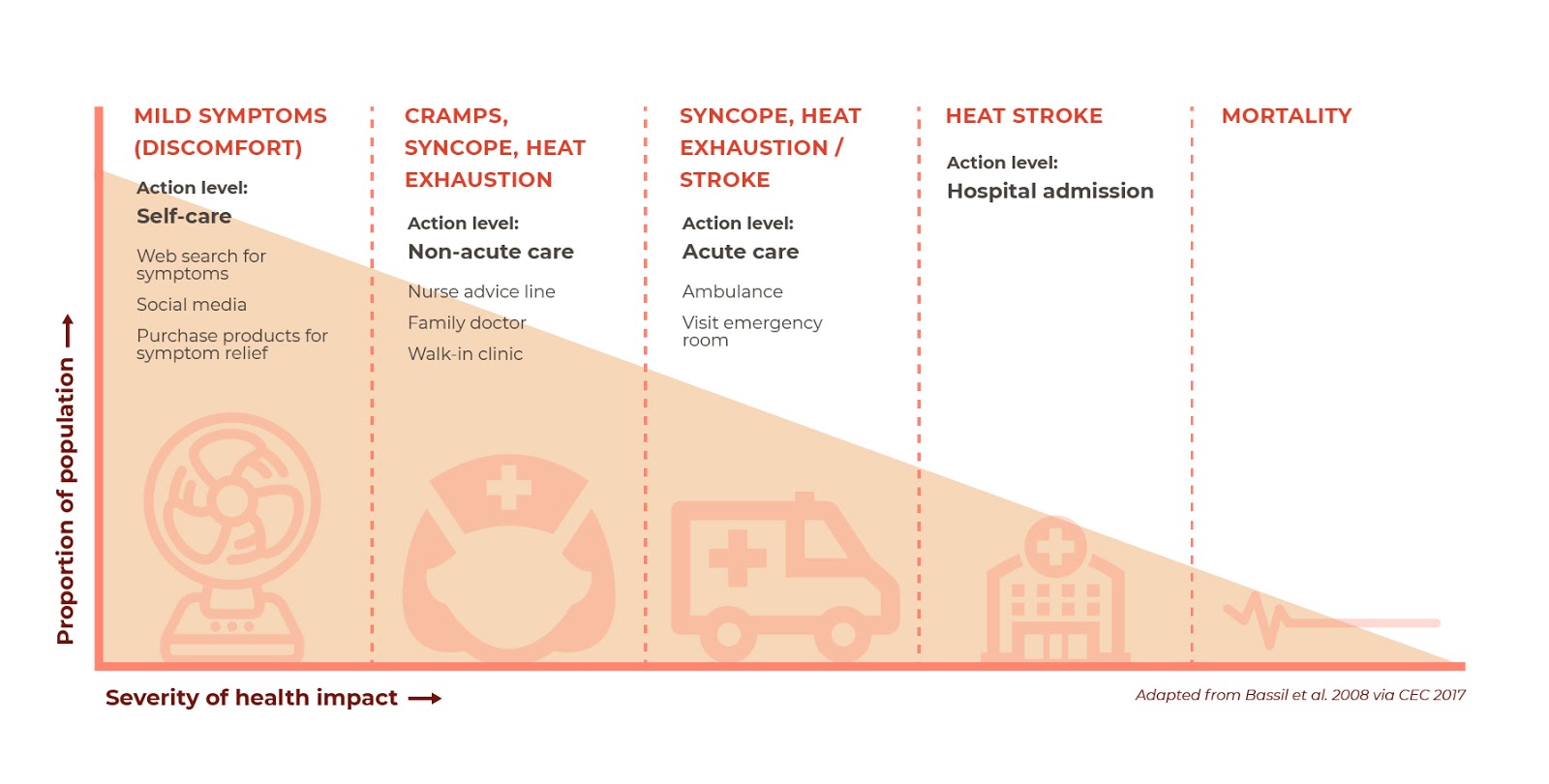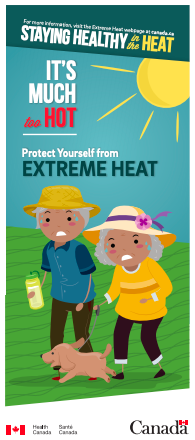Exposure to excessive heat presents wide-ranging and serious health risks.
It can amplify existing conditions and result in premature death, disability and illness, including exacerbation of non-communicable diseases and the effects of air pollution.
- Prolonged heat imbalance in the body can be life-threatening.
- Heatstroke is a medical emergency, while heat exhaustion is not usually serious if you can cool down within 30 minutes.
- Avoiding thermal risk and early recognition of heat stress are the cornerstones of prevention.
How the Body Processes Heat
Heat Balance
The human body tightly regulates the body temperature through a process called thermoregulation, in which the body can maintain its temperature within certain boundaries, even when the surrounding temperature is very different.
The core temperature of the human body remains steady at around 36.5-37.5 ºC (or 97.7º-99.5ºF) at rest. This is regulated by the hypothalamus in the brain, which senses changes in the core temperature and operates like a thermostat to induce mechanisms to return the temperature to its normal range. If the body temperature is rises, the hypothalamus can initiate several processes to lower it, including increasing the circulation of the blood to the surface of the body to allow for the dissipation of heat through the skin, and initiation of sweating to allow evaporation of water on the skin to cool the surface of the skin. Source Energy and Heat Balance
Heat Imbalance
Failure of thermoregulatory mechanisms or exposure to extreme or sustained temperatures that overwhelm the body’s thermoregulatory capacity can result in potentially life-threatening illnesses Source Thermoregulatory disorders and illness related to heat and cold stress . These include heat stroke, heat exhaustion, heat fainting, heat edema (swelling of hands, feet and ankles), heat rash and heat cramps (muscle cramps), and are mainly caused by over-exposure to extreme heat or physical overexertion for a person’s age and physical condition.
Understanding Heat Illness
Symptoms of Heat Related Illness
Hyperthermia, defined as a core temperature of > 40°C, may present with sweating, flushing, tachycardia, fatigue, lightheadedness, headache, and paresthesia, progressing to weakness, muscle cramps, oliguria, nausea, agitation, hypotension, syncope, confusion, delirium, seizures, and coma. Source Thermoregulatory disorders and illness related to heat and cold stress
Heat Stress/Exhaustion vs Heat Stroke
Changes in mental status can help distinguish 1 potentially fatal heat stroke from heat stress or exhaustion Source Thermoregulatory disorders and illness related to heat and cold stress . Heat exhaustion is not usually serious if you can cool down within 30 minutes, while heat stroke is a medical emergency. Source Heat exhaustion and heatstroke
Exertional vs Passive Heat Illness
Exertional heat stroke can develop in able-bodied individuals, such as athletes, soldiers, or laborers, and those performing rigorous physical activities in hot conditions.
In contrast, passive or nonexertional heat stroke can develop during low-level physical activities among elderly and very young children and babies, ambulatory individuals with comorbidities including obesity, diabetes, hypertension, heart disease, renal disease, dementia, and alcoholism who for physiological or behavioral reasons are unable to release heat from their bodies in hot conditions. Source Tool tip Learn more about managing and adapting to heat in sports and heat in at work.
Heat Stress vs Heat Stroke
Heat Stress / Exhaustion Heat Stroke
Signs Early warning signs include nausea, light-headedness, fatigue, muscle cramping and dizziness. In addition to the signs of heat stress, someone experiencing heat stroke may also have a headache, confusion, no sweating, rapid heart rate, nausea or vomiting and may lose consciousness
Response
- Move to an air-conditioned place
- Take a cold shower or use a cold compress
- Drink plenty of fluids
- Remove tight or extra clothing layers
- Call for medical help immediately
- Use aggressive cooling such as a cold water bath to get temperature down right away
- Stop cooling when core temperature of 38 degrees C is reached
- Do not give them fluids
| Heat Stress / Exhaustion | Heat Stroke | |
|---|---|---|
| Signs | Early warning signs include nausea, light-headedness, fatigue, muscle cramping and dizziness. | In addition to the signs of heat stress, someone experiencing heat stroke may also have a headache, confusion, no sweating, rapid heart rate, nausea or vomiting and may lose consciousness |
| Response |
|
|
Management and Adaptation Solutions
Management and adaptation to extreme heat in the body requires an awareness of the key concepts, signs and symptoms of heat-related illness, and an understanding of the measures that can be taken to reduce the initial core temperature and core temperature increase. Avoidance of thermal risk and early recognition of heat stress are the cornerstones of prevention.
Heat Acclimatization
Heat acclimatization is an adaptive response to a hot environment in which an individual’s body “learns” to better tolerate exposure to excessive heat. This adaptation is temporary and may take two weeks when daily exposed to heat, and is lost after some weeks of non-exposure.
Cooling
The main intention of cooling – such as submerging the body in cold water, or being in a cold room, or drinking cold fluids including ice slushies – is to lower the body’s temperature and reduce the risk of heat related illness. Ice water immersion has been shown to be superior to alternative cooling measures to quickly lower core body temperature. Source Thermoregulatory disorders and illness related to heat and cold stress
Spectrum of Heat Health Outcomes

Key Resources
Guidance
Clinical Guidelines on Management of Heat Related Illness at Health Clinic and Emergency and Trauma Department
Ministry of Health, Malaysia
2016
Booklet (EN / FR)
Review Article
Factsheet (Multiple Languages)
Page Contributors
Jason Lee, Hein Daanen, Nicola Gerrett
